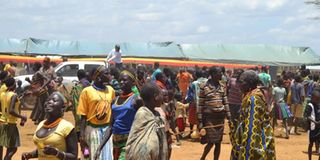It’s not all gloom in Karamoja

What you need to know:
Stories coming out of Karamoja are of hunger, death and despair. But it is not all gloom as beyond the forces of nature causing hunger, Karamoja is a region on the rise with residents adapting to modern practices.
When on my second evening in Moroto, I posted on my Facebook timeline that I was in Karamoja on journalistic duty, the first respondent to comment was a friend inquiring how I was feeling being around stark-naked Karamojong who shamelessly go about with their nether regions on display for everyone to see. I had to quickly inform this digital friend that actually the majority of Karimojong today dress up in clothes, –specifically in garments which, even as they may be far from fancy, suffice for the job of covering up the nether regions. I further informed my digital friend that while traversing Moroto District in the past two days, I hadn’t seen a single person walking around stark naked, and I cautioned him to beware that most stories about the state of Karamoja today are very backdated .
As I proceeded to recall and reflect on that famous phrase of ‘we shall not wait for Karamoja to develop,’ I was at the same time finding the motivation to gather and present some evidence that Karamoja is fast catching up with modernity and economic development.
No longer moving around naked
As indicated by my aforementioned Facebook friend, the sight of tribesmen of all ages and sizes running around stark-naked is what first comes to the average Ugandan’s mind when one mentions Karamoja. Going around naked is widely considered the most manifest and ubiquitous indicator of Karamoja’s backwardness, which no visitor to the region can miss.
Yet step in Karamoja as a first-time visitor, and you will see no naked people roaming the place. On the contrary, you will see everyone dressed up in fairly proper clothes, most people covering themselves in the light sheets (kangas) nomads across Africa tend to prefer, and a good number (especially in the towns and trading centres) in shirts and trousers and dresses.
“Even if you go to the remotest parts of the region, you have a very slim chance of seeing anyone move around naked without shame,” says journalist Wanyama, who has spent a decade in Karamoja moving to all its corners. “Actually the Karimojong never used to go around totally naked even before they adopted modern dressing practices; only that their garments were intentionally left revealing private parts like breasts and male reproductive organs in order to impress the opposite sex. But today, most of those garments have been dropped and residents cover up the bigger percentage of their bodies, with private parts fully covered.”
Wanyama credits the political, government and cultural leadership for the adoption of modern clothing in Karamoja, saying these have consistently preached the message of dressing up and sometimes even applied force.
Becoming a peaceful –even friendly people
Along with walking around naked, being extremely hostile –both among themselves and to outsiders– has long been pointed out as a majot indicator of the backwardness of the Karimojong. From raiding all neighbouring communities to rustle cattle, to shooting at cars passing through the region, to treating one another with indignity such as capturing wives from rival villages, the tales of hostility among the Karamojong have always been sundry.
However, as the Moroto District LC5 chairperson, Mr Mark Awor Musoka reckons, what many people don’t realise is that today, the Karimojong are no longer the perpetually hostile people they used to be.
“The disarmament campaign that government undertook in the region some years ago has brought about total peace and stability, and this peace and stability is the cornerstone of all the other developments we have achieved as a region,” says Musoka. “With the guns taken away, our people have generally given up the warrior attitudes of old and are living peacefully with each other. They no longer go rustling for cattle from each other or even neighbouring communities, and they are even becoming friendly and co-operative to outsiders who come here. With police stations establihsed, the rule of law has been introduced and anyone who commits an offence will be brought to law and order, so now a stranger can drive, ride or walk through any part of Karamoja they want without anyone touching them.”
Journalist Wanyama reiterates Musoka’s take here, saying that living in a town in Karamoja today is just like living in any other upcountry town, which is different from when he had just gone to the area a decade ago and the tribesmen had guns and fighting breaking out all the time, paralysing economic activity and social life.
Increasing physical infrastructure
For a first time visitor to Moroto, the first indicator that one is arriving in a town undergoing large infrastructural development, comes 10 kilometers away from the town, in form of the under-construction tarmac road that puts an end to the discomfort of the two-hour drive from Soroti. Then as soon as one is in the town itself, one gets to behold the large structures cropping up on the land, - from storeyed hotel buildings to grand mansions to hospital and school buildings.
“Twenty years ago, we had only about five health centres in the entire of Karamoja, and moreover they weren’t well-stocked with drugs and medical workers were scarcely around,” says Isa Dawuk, a cattle trader and community elder in Nakapiripirit. “But now we have health centres at most sub-county levels. We also didn’t have that many schools, yet now we have both primary and secondary schools at almost every sub-county. The roads coming to our place were totally impassable with real gullies in them, but now even as they aren’t yet tarmacked many of them are passable because they are regularly maintained.”
“Upgrading of the Nakapiritpiri-Moroto and Morot-Soroti roads to tarmac is underway, while Lira-Kotido is scheduled to start and many are other roads are in the upcoming budgets,” says Moroto LC5 Chairman Musoka in respect to road construction.
Yet even without talking to anyone, one can see emerging physical construction in Karamoja today, especially in the major towns of Moroto and Kotido. Impossible to miss is the surfeit of structures rising in the towns, some of them actually storeyed structures with two or more floors.
Monetised economy
“If you go to Aikakwat market which takes place here in Moroto Town every Monday, you will find a level of animal trade and commerce that’s one of the greatest in Uganda today. Over 1,000 animals are traded at the market every Monday, with 500 going to Kenya and then other 500 going to towns in Uganda, especially those in the eastern and northern part such as Lira, Mbale and Soroti, ” Moroto LC5 chairman Musoka expounds on how the natives of Karamoja are increasingly abandoning the business of surviving on only subsistence farming and picking up trade and commerce, especially with other people outside Karamoja.
“The days of people living on their cattle and the environment are long gone, now almost everyone has to buy the things that keep life moving,” says Dawuk an elder from Nakapiritpirit. “You buy food, you buy alcohol, you buy the animals, you generally buy everything. Even if you go to the remotest parts of Karamoja, people there trade using money; you find the rich ones with wads of cash in their Manyatas, and a number of those around the big towns have even embraced banking. Most of the major commercial banks have now opened branches here, and the biggest number of the banks’ clients are native Karamojong.”
Increasing social amenities
Wanyama, the journalist who has spent 10 years in Karamoja, says that when he first stepped in the region,one couldn’t even imagine the possibility of a nightclub, not even in the regional capital of Moroto. Yet today, Moroto town alone has three major nightclubs where people go to dance on almost all days of the week, not to mention the bars that keep the town lively into the late night every day –located in the liveliest part of town called Kamuswahili, which is a downtown hub more like a Makindye or Kabalagala of the town.
“We who had work to do in town would be back to our houses by 3pm, and we would sleep even before nightfall because there was simply nothing to be done anywhere in town,” recalls Wanyama. “So to think that today Karamoja even has recording artistes who go performing all over the region and enjoying superstar status like that enjoyed by the Chameleones in Kampala and other big towns!”
Indeed, the increasing number of social amenities in Karamoja is also self-evident, as walking on the streets of Moroto in the evening, this writer saw office-workers retired from their stations going about sports like football and basketball at different fields in the town.
And banker Jasper Okot, who is apart of a fitness team that runs through Moroto Town every evening, says there is every reason to hope that soon, Karamoja will have sports teams in different disciplines competing at the national level, even sports stars representing the country internationally.
By the time I left Karamoja, I was well aware that I couldn’t capture in one feature the evidence of Karamoja’s development and modernisation that I had seen. Of course I had also caught a number of the challenges that still hold the region back –the recurrent food crises, the perpetual water scarcity, illiteracy, the locals’ lack of job skills, among others–but on the whole, the region presented a hopeful image.
Mordern farming practices
“You only need to look at how people are now very eager to be part of any animal treatment or immunisation campaign that comes to Karamoja to see how much the people of Karamoja are embracing modern agricultural practices today,” says veterinary doctor Mukisa who has worked in Karamoja for the last five years. “People no longer fear to bring their animals for immunisation as the case used to be of old.”
Yet the voluntary yielding of their animals to immunisation and treatment is just one of the many ways in which the Karimojong have today embraced and continue to embrace modern farming practices. Driving or riding through the region, one can’t miss the sight of crop farming that is taking place especially in the greener parts of the region, which receive some fair amounts of rainfall. Here one sees gardens of sundry crops, from maize to beans to sweet potatoes, even to groundnuts.
“The Karimojong have gradually come to realise that relying on just nature is a bad way of trying to survive, so now most of them are adopting the modern farming methods,” Mukisa says, adding that government, NGOs and other humanitarian entities in the region have been behind this adaptation.




